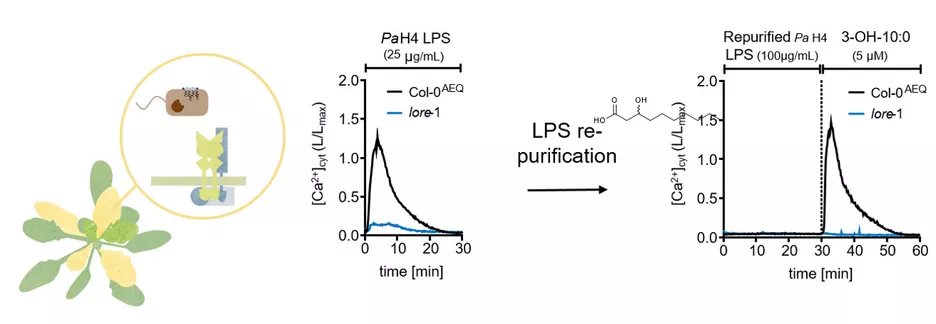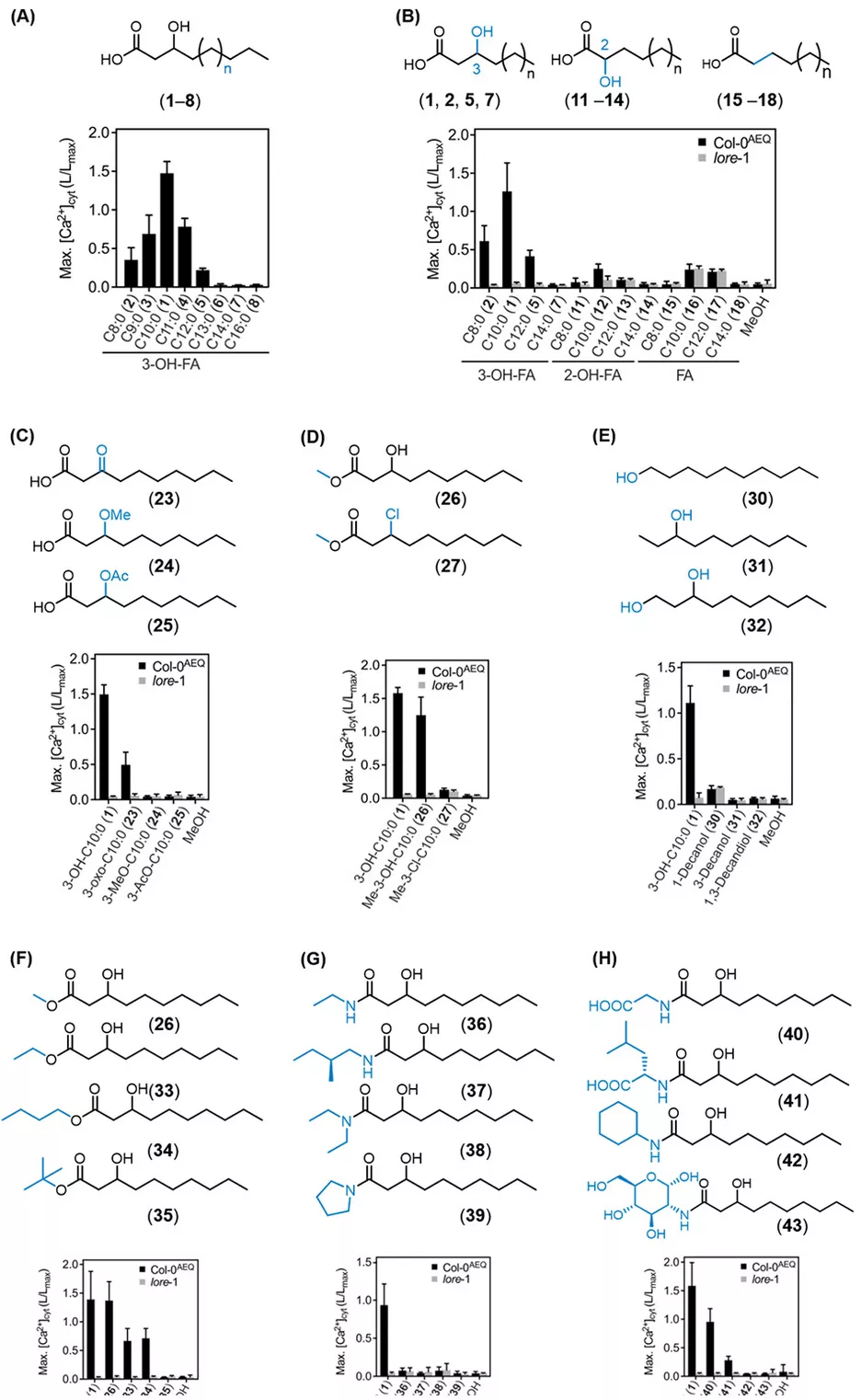From plant stress to metabolic response
This research pipeline combines state-of-the-art bio-response-based discovery and natural product methodologies, especially LC-TOF-MS, LC-MS/MS, 1D-/2D-NMR, and CD experiments, as well as chemical synthesis, to identify and characterize bioactive phytochemicals in microorganisms, crops, and model plants.
Example 1:
In close collaboration with a research group led by Prof. Dr. Stefanie Ranf (University of Fribourg in Switzerland), we defined a new role of lipopolysaccharides (LPS) in complex plant-microbe interactions. Previous research has found that LPS in most Gram-negative bacteria is itself a microbe-associated molecular pattern (MAMP) that activates LORE receptors. By thoroughly testing re-purified LPS samples, we found that neither lipid A nor LPS were MAMPs that induced plant-triggered immunity in Arabidopsis. Rather, 3-OH-decanoic acid is the “real” LORE agonist, preferably in its (R)-configuration, which presumably co-purifies with LPS and could be released by several bacteria (including but not limited to the selected Pseudomonas and Xanthomonas strains; Figure 1).

Structure-activity experiments after synthesis revealed the minimal motives of LORE activation (see Figure 2) mediated by medium chain 3-OH-fatty acids (mc-3-OH-FAs).

As highlighted in the pending patent PCT/EP2019/053836 (2019), mc-3-OH-FAs are promising targets for field applications as natural MAMPs. For example, Brassicaceae naturally harbor LORE and thus may be protected against several stresses by spraying 3-OH-fatty acids. In addition, 3-OH-fatty acid application may be a useful screening tool to identify Brassicaceae lines with a strong LORE-dependent immune response. Moreover, engineering plant species with a functional LORE through gene editing (Brassicaceae family) or transgenesis (not limited to the Brassicaceae family) to sense mc-3-OH-FAs or functional derivatives could be a useful strategy to increase broad-spectrum resistance among plants in the future. This approach would be particularly useful in countries in which genetically modified organisms (GMO) are approved. The development of new, cheap, sustainable, biotechnologically based strategies to produce 3-OH-fatty acids in reasonable amounts would provide great benefit.
Example 2:
Salix cortex-containing medicine is used to treat pain conditions, fever, headaches, and inflammation, which are partly mediated via arachidonic acid-derived prostaglandins. In close collaboration with a research group led by Prof. Dr. Evelyn Lamy, we used a bio-based fractionation strategy, followed by structure elucidation experiments using LC-MS/MS, CD-spectroscopy, and 1D/2D NMR techniques, to identify the compounds present in Salix extracts that are relevant for the inhibition of PGE2 release from activated human peripheral blood mononuclear cells (see Figure 3). Inflammation is an important therapeutic target for pharmacological interventions; thus, the identification of relevant key drugs in Salix could provide new prospects for the improvement and standardization of existing clinical medicine. In addition, we collaborated with research groups led by Dr. Inga Mewis and Prof. Dr. Christian Ulrichs to use UHPLC-TOF-MS and UHPLC-MS/MS quantitation methods to preselect Salix genotypes with high amounts of bioactives.
SELECTED PUBLICATIONS:
Kutschera, A.#; Dawid, C.#; Gisch, N.; Schmid, C.; Raasch, L.; Gerster, T.; Schäffer, M.; Smakowska-Luzan, E; Belkhadir, Y.; Vlot, C.; Chandler, C. E.; Schellenberger, R.; Schwudke, D.; Ernst, R.; Dorey, S.; Hückelhoven, R.; Hofmann, T.; Ranf, S. Bacterial medium-chain 3-hydroxy fatty acid metabolites trigger immunity in Arabidopsis plants. Science 2019, 364(6436), 178–181.
Schellenberger, R.; Crouzet, J.; Nickzad, A.; Kutschera, A.; Gerster, T.; Borie, N.; Dawid, C., Cloutier, M.; Villaume, S.; Dhondt-Cordelier, S., Hubert, J.; Cordelier, S.; Mazeyrat-Gourbeyre, F.; Schmid, C.; Ongena, M., Renault, J.-H.; Haudrechy, A.; Hofmann, T.; Baillieul, F.; Clement, C.; Zipfel, C.; Gauthier, C.; Déziel, E.; Ranf, S.; Dorey, S. Bacterial rhamnolipids and their 3-hydroxyalkanoate precursors activate Arabidopsis innate immunity through two independent mechanisms. PNAS 2021, 118(39), e2101366118.
Antoniadou, K.; Herz, C.; Le, N. P. K.i; Mittermeier-Kleßinger, V. K.; Förster, N.; Zander, M.; Ulrichs, C.; Mewis, I.; Hofmann, T.; Dawid, C.*; Lamy, E. Identification of salicylates in willow bark (Salix cortex) for targeting peripheral inflammation. Int. J. Mol. Sci. 2021, 22(20), 11138.
Le, N. P. K.; Herz, C.; Gomes, J. V. D.; Förster, N.; Antoniadou, K.; Mittermeier-Kleßinger, V. K.; Mewis, I.; Dawid, C.; Ulrichs, C.; Lamy, E. Comparative anti-inflammatory effects of Salix cortex extracts and acetylsalicylic acid in SARS-CoV-2 peptide and LPS-activated human in vitro systems. Int. J. Mol. Sci. 2021, 22, 6766.
Förster, N.; Antoniadou, K.; Zander, M.; Baur, S.; Mittermeier-Kleßinger, V. K.; Dawid, C.; Ulrichs, C.; Mewis, I. Chemoprofiling as breeding tool for pharmaceutical use of Salix. Front. Plant Sci. 2021, 12, 511.
Dawid, C.#; Weber, D.#; Musiol, E.; Janas, V.; Baur, S.; Lang, R.; Fromme, T. Comparative assessment of purified saponins as permeabilization agents during respirometry. BBABIO 2020, 1861(10), 148251.
Hager, R.; Pitsch, J.; Kerbl-Knapp, J.; Neuhauser, C.; Ollinger, N.; Iken, M.; Ranner, J.; Mittermeier-Kleßinger, V.; Dawid, C.; Lanzerstorfer, P.; Weghuber, J. A high-content screen for the identification of plant extracts with insulin secretion-modulating activity. Pharmaceuticals 2021, 14(8), 809.
Bräcker, L. B.; Gong, X.; Schmid, C.; Dawid, C.; Ulrich, D.; Phung, T.; Leonhard, A.; Ainsworth, J.; Olbricht, K.; Parniske, M.; Gompel, N.
A strawberry accession with elevated methyl anthranilate fruit concentration is naturally resistant to the pest fly Drosophila suzukii. PLOS ONE 2020, 15(6),
e0234040.
Beltrán, L. R.; Dawid, C.; Beltrán, M.; Gisselmann, G.; Degenhardt, K.; Mathie, K.; Hofmann, T.; Hatt, H. The pungent substances piperine, capsaicin, 6-gingerol and polygodial inhibit the human two-pore domain potassium channels TASK-1, TASK-3 and TRESK. Front. Pharm. 2013, 4(141), 1–11.
Mathie, K.; Lainer, J.; Spreng, S.; Dawid, C.; Andersson, D. A.; Bevan, S.; Hofmann, T. Structure-pungency relationships and TRP channel activation of drimane sesquiterpenes in Tasmanian pepper (Tasmannia lanceolata). J. Agric. Food Chem. 2017, 65(28), 5700–5712.
Wang, Y.#; Dawid, C.#; Kottra, G.; Daniel, H.; Hofmann, T. Gymnemic acids inhibit the sodium-dependent glucose transporter 1. J. Agric. Food Chem. 2014, 62, 5925–5931.
Jaramillo, K.; Dawid, C.; Hofmann, T.; Fujimoto, Y.; Osorio, C. Identification of antioxidative flavonols and anthocyanins in Sicana odorifera fruit peel. J. Agric. Food Chem. 2011, 59, 975–983.

